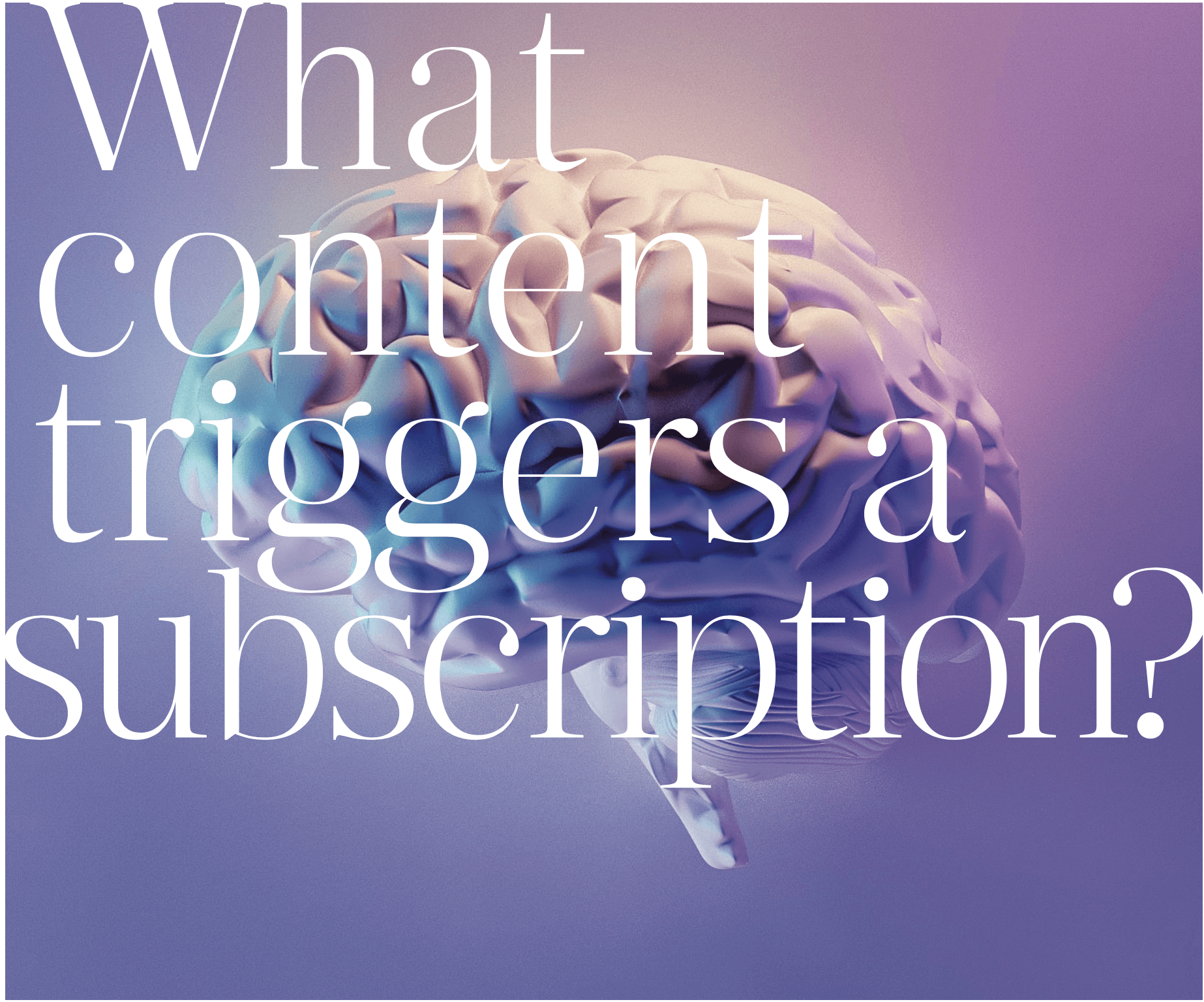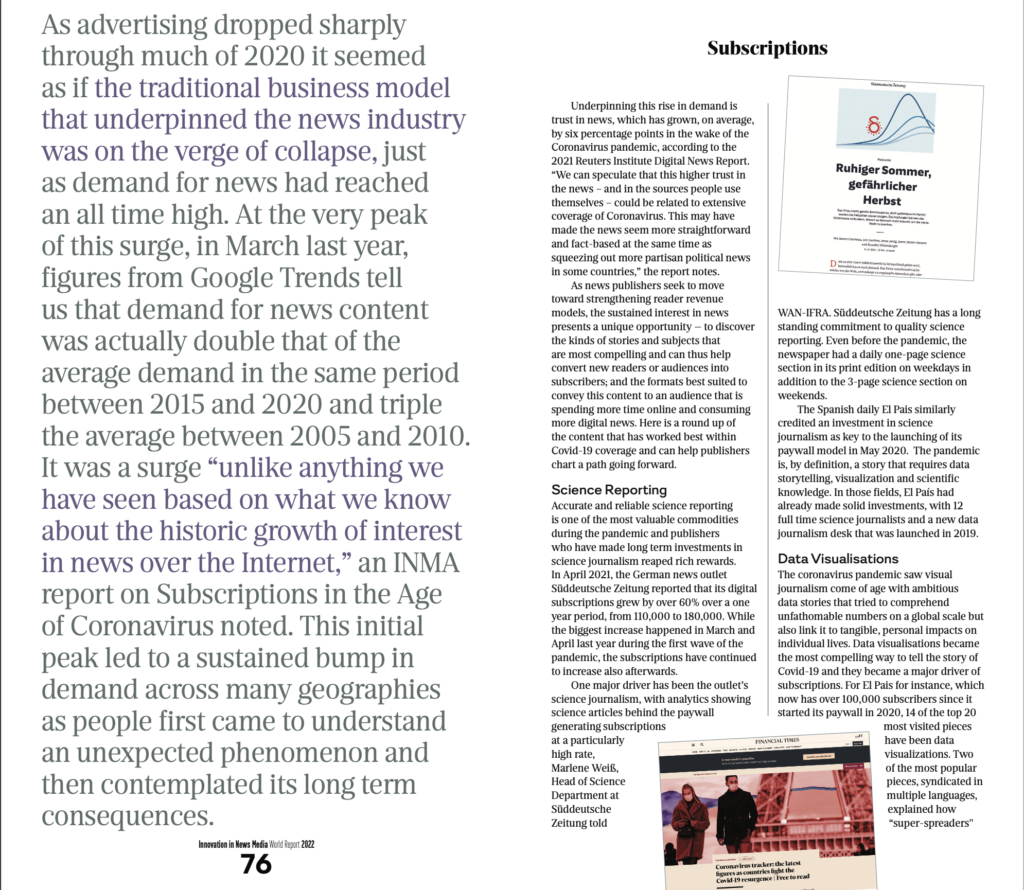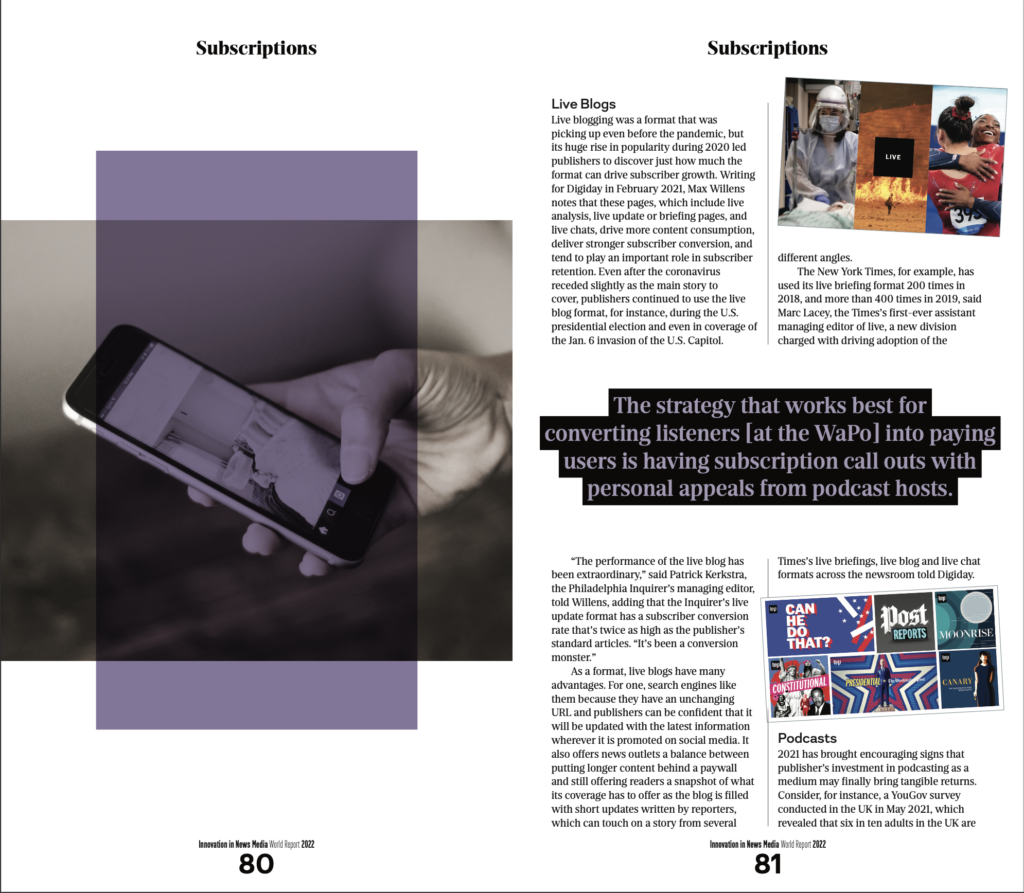
16 May What Content Triggers a Subscription?
As advertising dropped sharply through much of 2020 it seemed as if the traditional business model that underpinned the news industry was on the verge of collapse, just as demand for news had reached an all time high. At the very peak of this surge, in March last year, figures from Google Trends tell us that demand for news content was actually double that of the average demand in the same period between 2015 and 2020 and triple the average between 2005 and 2010. It was a surge “unlike anything we have seen based on what we know about the historic growth of interest in news over the Internet,” an INMA report on Subscriptions in the Age of Coronavirus noted. This initial peak led to a sustained bump in demand across many geographies as people first came to understand an unexpected phenomenon and then contemplated its long term consequences.
Underpinning this rise in demand is trust in news, which has grown, on average, by six percentage points in the wake of the Coronavirus pandemic, according to the 2021 Reuters Institute Digital News Report. “We can speculate that this higher trust in the news – and in the sources people use themselves – could be related to extensive coverage of Coronavirus. This may have made the news seem more straightforward and fact-based at the same time as squeezing out more partisan political news in some countries,” the report notes.
As news publishers seek to move toward strengthening reader revenue models, the sustained interest in news presents a unique opportunity — to discover the kinds of stories and subjects that are most compelling and can thus help convert new readers or audiences into subscribers; and the formats best suited to convey this content to an audience that is spending more time online and consuming more digital news. Here is a round up of the content that has worked best within Covid-19 coverage and can help publishers chart a path going forward.
SCIENCE REPORTING
Accurate and reliable science reporting is one of the most valuable commodities during the pandemic and publishers who have made long term investments in science journalism reaped rich rewards.
In April 2021, the German news outlet Süddeutsche Zeitung reported that its digital subscriptions grew by over 60% over a one year period, from 110,000 to 180,000. While the biggest increase happened in March and April last year during the first wave of the pandemic, the subscriptions have continued to increase also afterwards. One major driver has been the outlet’s science journalism, with analytics showing science articles behind the paywall generating subscriptions at a particularly high rate, Marlene Weiß, Head of Science Department at Süddeutsche Zeitung told WAN-IFRA. Süddeutsche Zeitung has a long standing commitment to quality science reporting. Even before the pandemic, the newspaper had a daily one-page science section in its print edition on weekdays in addition to the 3-page science section on weekends.
The Spanish daily El Pais similarly credited an investment in science journalism as key to the launching of its paywall model in May 2020. The pandemic is, by definition, a story that requires data storytelling, visualization and scientific knowledge. In those fields, El País had already made solid investments, with 12 full time science journalists and a new data journalism desk that was launched in 2019.
DATA VISUALISATIONS
The coronavirus pandemic saw visual journalism come of age with ambitious data stories that tried to comprehend unfathomable numbers on a global scale but also link it to tangible, personal impacts on individual lives. Data visualisations became the most compelling way to tell the story of Covid-19 and they became a major driver of subscriptions. For El Pais for instance, which now has over 100,000 subscribers since it started its paywall in 2020, 14 of the top 20 most visited pieces have been data visualizations. Two of the most popular pieces, syndicated in multiple languages, explained how “super-spreaders” are responsible for the most infections. The Financial Times found its datadriven living infographic on the spread of the virus, which was updated as new data comes in, became the most-read article in the history of the newspaper.
FT put this article outside the paywall, pushed it heavily on social media, and used it to try and expose more readers to FT journalism. A single article thus became a major route for attracting new reader revenue. Similarly, an infographic that the Washington Post published in 2020, using a made-up disease called “simulitis” to simplify the complex concept of virus transmission and demonstrate the benefits of social distancing, became its most-read online piece ever.

POP-UP NEWSLETTERS
While science reporting and data journalism did the heavy lifting, newsletters have cemented their place across the last year as the most versatile tool in the publisher’s arsenal. Across 2020 and 2021, publishers experimented with various iterations of the “pop-up” newsletter, delivering a curated selection of reading to help readers chart the course of the major coronavirus pandemic, and helping them look beyond.
The swiftness with which newsletters can be deployed to respond to major news events has been key to driving both engagement and subscriptions. The Washington Post for example, in the span of just two months, saw its coronavirus newsletter become by far the most popular of the more than 70 newsletters it offers. The New York Time similarly reported that Its newsletters around big news events, including the “Coronavirus Briefing,” “Coronavirus Schools Briefing,” “Impeachment Briefing” and “At Home” had over 180 million opens. Newsletters are important tools for habit forming, allowing readers to sample content, as well as providing a publisher with a large number of registered users who can be converted to subscribers. When The New York Times reported a slight drop off in the number of new paying subscribers acquired in the first quarter of 2021, it nevertheless pointed to the company’s large user base — roughly 15 million people are reading on of the Times’ newsletters every week — as grounds that it could “profitably scale paid subscriptions over time.”
In August 2021, The Times made about a third of its existing newsletters exclusive to subscribers, simultaneously announcing a new slate of newsletters that would be subscribers-only. Similarly, the digital business news outlet Quartz has also made newsletters a central part of its subscription programme, launching four new memberonly newsletters this year.
LIVE BLOGS
Live blogging was a format that was picking up even before the pandemic, but its huge rise in popularity during 2020 led publishers to discover just how much the format can drive subscriber growth. Writing for Digiday in February 2021, Max Willens notes that these pages, which include live analysis, live update or briefing pages, and live chats, drive more content consumption, deliver stronger subscriber conversion, and tend to play an important role in subscriber retention. Even after the coronavirus receded slightly as the main story to cover, publishers continued to use the live blog format, for instance, during the U.S. presidential election and even in coverage of the Jan. 6 invasion of the U.S. Capitol.
“The performance of the live blog has been extraordinary,” said Patrick Kerkstra, the Philadelphia Inquirer’s managing editor, told Willens, adding that the Inquirer’s live update format has a subscriber conversion rate that’s twice as high as the publisher’s standard articles. “It’s been a conversion monster.” As a format, live blogs have many advantages. For one, search engines like them because they have an unchanging URL and publishers can be confident that it will be updated with the latest information wherever it is promoted on social media. It also offers news outlets a balance between putting longer content behind a paywall and still offering readers a snapshot of what its coverage has to offer as the blog is filled with short updates written by reporters, which can touch on a story from several different angles.
The New York Times, for example, has used its live briefing format 200 times in 2018, and more than 400 times in 2019, said Marc Lacey, the Times’s first-ever assistant managing editor of live, a new division charged with driving adoption of the Times’s live briefings, live blog and live chat formats across the newsroom told Digiday.
PODCASTS
2021 has brought encouraging signs that publisher’s investment in podcasting as a medium may finally bring tangible returns. Consider, for instance, a YouGov survey conducted in the UK in May 2021, which revealed that six in ten adults in the UK are now willing to pay for online content with 10% saying they would pay to read online news articles. 18 to 24-year-olds however, said they were less likely to pay for news (5%) but more than double as likely to pay for podcasts (11%). The trend is similar across different markets. The Washington Post for example, found that its paying users, who also listen to podcasts, tend to be the brand’s youngest subscribers and fall in the 18-44 age group, thus making podcasts crucial to the company’s overall revenue strategy. And the strategy that works best for converting listeners into paying users is having subscription call outs with personal appeals from podcast hosts.
The Post’s podcast listenership spiked 20 percent during the pandemic, especially among young listeners, Maggie Penman, executive producer of Post Reports, told a WAN-IFRA conference in June, 2021. Other publishers have identified developing podcasts as being key to subscriber growth. The Economist, which reported a record subscriber growth of 90,000 in 2021, its largest-ever increase in a single year, attributed the rise to new products. A new podcast, “The Jab,” analyzed the global vaccine roll-out while newsletters, such as “Simply Science” and “Off the Charts,” catered to growing areas of reader interest. Still others see an opportunity in converting audiences who listen to podcasts, which largely remain free as of now, to subscribers.
Bloomberg is following this strategy with the popular Odd Lots podcast which takes a deep dive into financial markets. The majority of listeners were younger compared to its existing subscriber base; over two thirds were non-subscribers. Earlier this year, the company launched a suite of subscriber-only content — including a weekly newsletter and daily blog — aimed at this section of listeners who are not yet subscribed.

VIDEO AND LIVE STREAMING
With much of the world on lockdown for extended periods of time, it’s no surprise that media behaviours and habits have evolved and video streaming has received a particularly sizable bump. Can publishers capitalise on this trend?
It’s not an approach that works for everybody and there are numerous examples of publishers investing in short news videos without any tangible financial return. However, a few have developed models for video that can help drive subscriber acquisition. One of the winners at the 2021 INMA global media awards, The Courier Mail in Australia identified an opportunity in streaming college sports as campuses were beginning to open and starting sporting events, but parents weren’t allowed to attend. The news outlet hired a reporter to solely cover college sport, bought equipment; signed partnerships with universities and started streaming over 500 games throughout the year, even developing a weekly highlights show.
More than 4000 new subscribers signed on to watch the games and the news outlet reported that 12.5% of The Courier-Mail’s subscriptions came from live streams in 2020. The Courier Mail is building on the work done in building successful models for live sport streaming by publishers like Norway’s Amedia and Sweden’s Bonnier which have both seen substantial digital subscription growth from live streaming local sports.
A handful of publishers have found success with other genres of video. In 2019, Digiday reported that video was emerging as a top subscription driver for the German tabloid Bild with the news outlet finding that eight of the top ten highest-converting articles were either video documentaries or had video in some form. Bild started putting more and more video content behind its premium tier of content called Bild Plus and found particular success conversions with documentaries, especially those about crime. Videos were either about specific criminal cases or a series on organised crime.
PERSONAL ADVICE COLUMNS
In times clouded by uncertainty, it stands to reason that well written advice columns will drive both user engagement and subscriptions. An excellent example is the series of advice columns run by online magazine Slate which receive hundreds of submitted questions every week and receive hundreds of thousands of views. Over the past two years, the publisher’s first three advice columns — one on parenting called Care and Feeding, a sex and relationship column How To Do It, and its longstanding general advice column Dear Prudence — saw page views increase by 67% while unique visitors rose by 244%, Digiday reported. The success of the columns led the publisher to launch a fourth column called Pay Dirt, in May 2021, that talks about money in the context of how it impacts personal relationships. Because traffic is so significant to these pages, in aggregate, the advice columns are the biggest driver of programmatic ad dollars, according to the company. The high engagement has also translated into it being a significant converter of readers to paid subscribers as well, with advice being one of the top reasons people become Slate Plus members, Bill Carey, Slate’s director of strategy, told Digiday.


